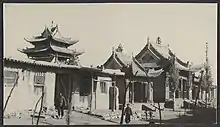Weizhou Grand Mosque
The Weizhou Grand Mosque (Chinese: 韦州清真大寺) is a mosque in Tongxin County, Wuzhong City, Ningxia Hui Autonomous Region, China. Plans to demolish the mosque led to widespread protests in 2018 and 2019.
History

Weizhou's old mosque was constructed during the Ming dynasty in a traditional Chinese palatial style. It was named by the American Episcopal missionary Charles L. Pickens, Jr., who traveled western China in the 1920-1930s and documented many places and people, as "one of the most beautiful in all China."[1] It was destroyed during the Cultural Revolution in the 1960s.[2][3][4]
Plans for a reconstruction were made and began in 2015, with plans approved by local authorities. Chinese officials claim that the mosque was expanded beyond the plans approved, in an Arab rather than Chinese style. Local officials were criticized by the Commission for Discipline Inspection of Wuzhong City in May for their lack of supervision during the mosque's renovations.
Proposed demolition
Ningxia officials stated on 3 August 2018 that the mosque will be forcibly demolished on Friday because it had not received the proper permits before construction.[5][6][7] The Weizhou Grand Mosque was built in Tongxin County, Wuzhong City with about 23 million Muslim population, Ningxia Hui Autonomous Region. Local government accepted the rebuilding of Weizhou Grand Mosque in 2015, and its work started the same year.[8] After the renovation was finished, the scale of the mosque was bigger than the standards.[6]
A local Chinese Communist Party document mentioned that the Weizhou Grand Mosque had been carrying out illegal extensions since 2016, so it must be demolished.[9] Officials in the town were saying the mosque had not been given proper building permits, because it is built in a Middle Eastern style and include numerous domes and minarets.[5][6][7] The residents of Weizhou were alarmed each other by social media and finally stopped the mosque destruction by public demonstrations.[6][7]
Incident
According to Reuters news agency, the Ningxia officials "forcibly demolished" notice was shared online among the ethnic Hui Muslim community, and in a rare demonstration against the Chinese government, thousands of ethnic Hui Muslims had gathered at the mosque location to protest its planned demolition.[5][6] Public demonstrations are rare in China, because the government quickly suppresses any "hint of dissent".[6] However, shared videos on social media was showing large crowds gathered outside the Grand Mosque in the town of Weizhou to protect it.[6] The Hui are the largest of the 10 Muslim minority groups within China, and speak a variation of Mandarin — the language spoken by China's majority Han ethnic group.[9]
According to the Hong Kong-based South China Morning Post newspaper, the main question of protesters was: "why the authorities had not stopped construction of the mosque during its two years of construction, if it had not been granted relevant permits?"[5][9]
An official from the local Islamic Association told Reuters news agency that the mosque would not be demolished entirely and they only fix some changes on the building structure, such as remove eight domes.[5][9] Associated Press news agency reported, the Muslim community and protesters will never accept this proposal.[5] Documents show that protesters of Hui Muslims were standing at the Weizhou Grand Mosque location. They carried Chinese national flags and many banners which expressing support for the Communist Party, ethnic unity, and religious freedom.[9] Many protesters stood outside the local government offices when waving the same banners, too.[9]
James Leibold, an expert on China's ethnic policy at La Trobe University said, the Hui Muslims, because of their common language, broken traditionally role in region between politicians and Muslim minority groups.[9]
Reactions
| Part of a series on Islam in China |
|---|
.jpg.webp) |
|
|
Stephen McDonell, the BBC's China correspondent, reported: "For centuries Hui Muslim mosques were built in a more Chinese style, but the local government considered the Grand Mosque in the town of Weizhou as an example of a growing Arabic architecture between Chinese Muslim."[5][9]
According to ABC news, many Weibo users in China were agreeing with the pulling down of the mosque.[9]
A group of American lawmakers publicly asked the United States government to do more sanctions on Xinjiang, especially against key Chinese officials and politicians who had a role in demolishing the mosque.[10]
References
- "Weichow, Ningsia. Entrance and minaret of mosque. | Historical Photographs of China".
- "Hui mosque protest ends after official vows to consult community". South China Morning Post. August 14, 2018.
- "Thousands of Muslims protest against the demolition of the Weizhou Grand Mosque". www.asianews.it.
- "Chinese Hui Muslims continue protest at Weizhou Grand Mosque". South China Morning Post. August 10, 2018.
- "China mosque demolition sparks standoff in Ningxia". bbc.com. BBC News. 10 August 2018. Retrieved 8 April 2019.
- Osborne, Samuel (10 August 2018). "Thousands of Muslims protest China's plans to demolish mosque in rare demonstration against government". independent.co.uk. Independent. Retrieved 8 April 2019.
- Martina, Michael (10 August 2018). "Chinese Muslims protest against plan to demolish mosque". Reuters. reuters.com. Retrieved 14 April 2019.
- "Plans to demolish Weizhou Grand Mosque in China put on hold". South China Morning Post. 2018-08-12. Retrieved 2019-10-27.
- Walsh, Michael; Li, wires, Michael (11 August 2018). "Chinese Muslims surround mosque to prevent demolition amid Beijing push to control religion". abc.net.au. ABC News. Retrieved 8 April 2019.
- Doffman, Zak (6 April 2019). "China 'Destroying' Mosques As U.S. Senators Urge Americans To Stop Funding Xinjiang". forbes.com. Forbes. Retrieved 9 April 2019.